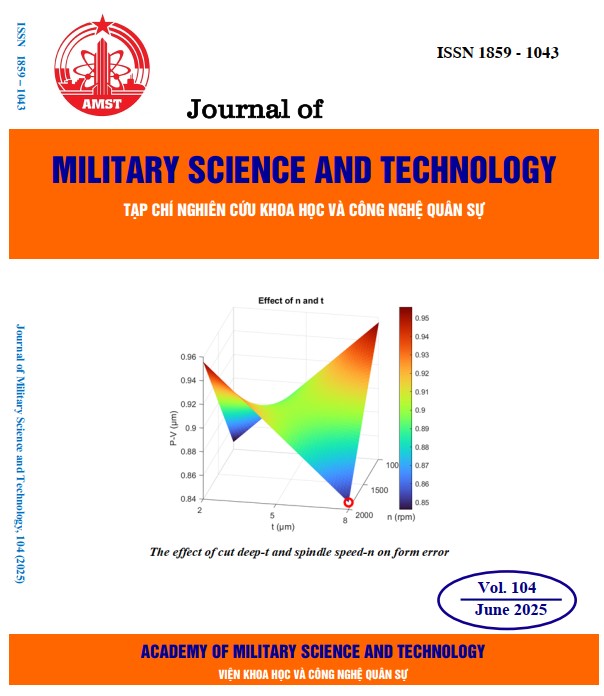A crypto-coding method based on punctured turbo codes for wireless communication systems
251 viewsDOI:
https://doi.org/10.54939/1859-1043.j.mst.104.2025.34-40Keywords:
Crypto-coding; Turbo codes; Punctured block; BER.Abstract
Encryption and error correction play important roles in secure and reliable wireless communication systems. However, these two functions are performed independently in two different layers which consume a lot of resources. In this work, a crypto-coding method is proposed for these two functions in a single step to reduce the computational complexity and hardware structure. The proposed crypto-coding method is implemented by using a secret key to control the punctured block of the Turbo codes. The secret key is generated from the wireless channel characteristics of single-input single-output (SISO) systems, which ensures the randomness according to the National Institute of Standards and Technology (NIST) version 800-22REV1A. The simulations are executed through the Additive White Gaussian Noise (AWGN) and Rayleigh channels. The simulated results show that the generated keys satisfy the randomness according to the NIST standard, which is evaluated by p -values below 0.01. In addition, the proposed crypto-coding method effectively improves the error correction ability and provides the same computational complexity as the conventional Turbo codes. Meanwhile, this method does not require any extra hardware to manage and distribute secret keys.
References
[1]. D. Van Linh and V. Van Yem, “A turbo-based encryption and coding scheme for multiple-input multiple-output orthogonal frequency division multiplexing wireless communication systems affected by Doppler frequency offset,” IET Commun., (2023), doi: 10.1049/cmu2.12568. DOI: https://doi.org/10.1049/cmu2.12568
[2]. D. Van Linh, V. Van Yem, and H. T. T. Phuong, “Crypto-coding technique based on polar code and secret key generated from wireless channel characteristics for wireless communication systems,” PLoS One, pp. 1–20, (2025), doi: 10.1371/journal.pone.0318110. DOI: https://doi.org/10.1371/journal.pone.0318110
[3]. C. Berrou, A. Glavieux, and P. Thitimajshima, “Near SHANNON limit error-correcting coding and encoding: Turbo-codes,” IEEE Int. Conf. Commun., no. 1, pp. 1064–1070, (1993). DOI: https://doi.org/10.1109/ICC.1993.397441
[4]. D. Kuswanto and A. Rachmad, “Combination Scheme of Aes Encryption and Error Correction Turbo Code for Cryptography of Cloud Storage,” in International Conference on Science and Technology (IICST 2018), no. January, pp. 720–724, (2018), doi: 10.2991/icst-18.2018.146. DOI: https://doi.org/10.2991/icst-18.2018.146
[5]. D. Kuswanto, “Performances Combination Schemes AES-Turbo Code Based-on Keys Length,” IOP Conf. Ser. Mater. Sci. Eng., vol. 1125, no. 1, p. 012047, (2021). DOI: https://doi.org/10.1088/1757-899X/1125/1/012047
[6]. T. J. Jeyaprabha and G. Sumathi, “A pragmatic study on hybrid-crypto-coding schemes for secure data access,” J. Internet Technol., vol. 22, no. 2, pp. 371–384, (2021).
[7]. D. Van Linh and V. Van Yem, “A Novel Scheme for Joint Error Control and Dynamic Security Coding Using Puncturing Mechanism,” J. Commun., vol. 17, no. 11, pp. 948–955, (2022), doi: 10.12720/jcm.17.11.948-955. DOI: https://doi.org/10.12720/jcm.17.11.948-955
[8]. T. H. M. Soliman, F. Yang, and S. Ejaz, “A proposed chaotic-switched turbo coding design and its application for half-duplex relay channel,” Discret. Dyn. Nat. Soc., vol. 2015, (2015). DOI: https://doi.org/10.1155/2015/818421
[9]. D. Abbasi-Moghadam and V. T. Vakili, “Enhanced secure error correction code schemes in time reversal UWB systems,” Wirel. Pers. Commun., vol. 64, no. 2, pp. 403–423, (2012), doi: 10.1007/s11277-010-0206-2. DOI: https://doi.org/10.1007/s11277-010-0206-2
[10]. T. H. T. Nguyen and J. P. Barbot, “Joint error control and dynamic security coding,” Int. Conf. Adv. Technol. Commun., pp. 285–290, (2013). DOI: https://doi.org/10.1109/ATC.2013.6698123
[11]. K. S. Arkoudogiannis and C. E. Dimakis, “Performance analysis of the odd-even uniform interleaver for turbo codes,” IET Commun., vol. 13, no. 16, pp. 2469–2477, (2019), doi: 10.1049/iet-com.2018.6250. DOI: https://doi.org/10.1049/iet-com.2018.6250
[12]. D. Van Linh and V. Van Yem, “Key Generation Technique Based on Channel Characteristics for MIMO-OFDM Wireless Communication Systems,” IEEE Access, vol. 11, no. January, pp. 7309–7319, (2023), doi: 10.1109/ACCESS.2023.3238573. DOI: https://doi.org/10.1109/ACCESS.2023.3238573
[13]. D. Van Linh, H. T. P. Thao, and V. Van Yem, “A Hybrid of Encryption and Error Correction Method for Multiple-Input Multiple-Output Wireless Communication Systems,” Int. J. Commun. Networks Distrib. Syst., vol. 30, no. 1, (2024), doi: 10.1504/ijcnds.2024.10061300. DOI: https://doi.org/10.1504/IJCNDS.2024.141669







